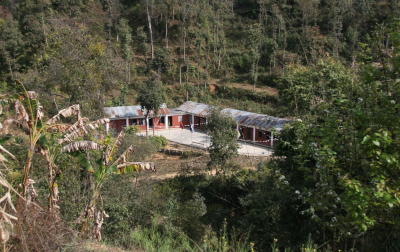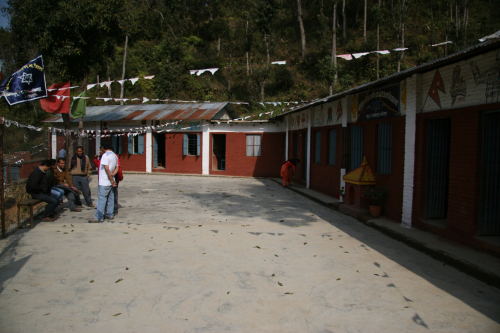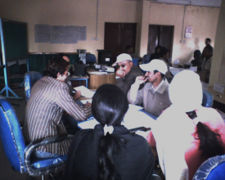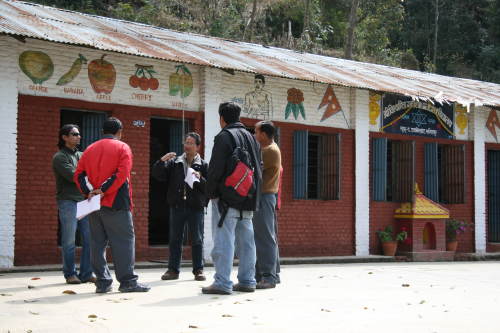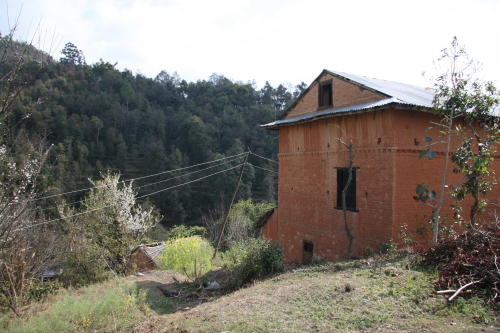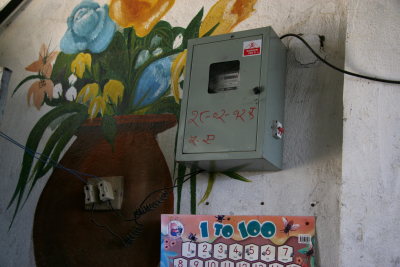Bishwamitra Journal
Bishwamitra Lower Secondary School
I will note down the details of this pilot school as they happen. Bryan Berry 08:42, 7 March 2008 (EST)
See also Bashuki_Journal for information on Nepal's other pilot school.
Contents
Background
The pilot will begin on the first day of the Nepali school year, April 14th.
Community
Bishwamitra School is located in the village of Lamatar, roughly 8 km east of Kathmandu.
The School
The school is roughly 30 minutes walk from the main road. This school is more accessible than Bashuki School. It is a poor school with a mix of Dalit (untouchable), Chettry, and Brahmin children. It is physically much smaller than Bashuki school and has a smaller student population.
Below is a closer view of the school. It is physically very small and serves roughly 240 kids, classes 1-8.
Teachers from Bashuki and Bishwamitra schools attended OLE Nepal's Teacher Interaction Program held in cooperation with Nepal's National Center for Educational Development, Nepal's national teacher training organization.
Implementation Team
Open Learning Exchange Nepal is the lead implementer for the pilot, cooperating with Nepal's Department of Education. The Danish IT Society has purchased the XO's for the pilot and the Embassy of Denmark in Nepal is covering the other costs.
From the Department of Education:
- Baburam Poudel - Deputy Director at the Department of Education, oversees the OLPC project in Nepal
- Kamal Kafle - Goverment's technical adviser to the project
- Arjun Aryal - government technical advisor
From OLE Nepal
- Rabi Karmacharya, Executive Director
- Dr. Saurav Dev Bhatta, Education Director
- Mahabir Pun, Networking and Infrastructure
- Sulochan Acharya, all technical matters at the school, esp. XO's and School Server
- Dev Mohanty, Network Technician for wireless links
- Ram Krishna Singh, power technician
- Bryan Berry, systems engineer, School Server, XO configuration, E-Library
There is also a activity development team at OLE Nepal that is working exclusively on creating constructionist learning activities for the pilot. They are less involved in the on-site implementation details.
From Bashuki School:
- Shiva Hari Dahal, principal
- Raju Ghimire, vice principal
The combined implementation team has been working together for over 4 months preparing for this pilot. It has been our experience so far that an OLPC pilot requires a significant amount of human resources. It would not be possible to implement a pilot in Nepal without full-time staff. We do not think it could be accomplished w/ a team of part-time volunteers. The OLE Nepal team includes volunteers, but the core team works on the project full-time.
I have discussed the matter of full-time staff with Amit Gogna, the lead implementer for India's first pilot at Khairat. He agrees that an OLPC implementation, even for a single school, requires full-time staff. His team has a total of 7 persons. One of the goals for our implementation team is to streamline the implemenation process for OLPC so it can be implemented with a minimum of human resources and use local resources wherever possible.
Planning
Network
Mahabir Pun is in charge of all network and infrastructure planning and Dev Mohanty is the network technician.
We are using Point-to-Point 802.11g radios to provide Internet access to the school. We will put the Point-to-Point radio for Bashuki School either at the adjacent Military Post or on a tree situated on a high hilltop. The radio located near Bashuki will connect to a radio multi-point radio located at the Department of Education, 8 km east of the school and in direct line of sight.
We may use a 12 db omni-directional access point from Deliberant Networks, onsite at the school. We will likely not use the Active Antenna, at least initially. We are using a Deliberant DLB-2700 for the access point. It costs roughly 100 euro and has a range of 12 km in ideal conditions. It operates in the wifi range.
We are using X brand of radio for the point-to-point connection to the Department of Education. The radio has an effective bandwidth 8 Mbps (to be confirmed). Since the radio will be transmitting at a distance of X km to the Department of Education located in the Kathmandu Valley, interference will be an issue.
We do not intend to use VSAT for any of Nepal's pilot schools. Installation is not terribly expensive but monthly bandwidth charges are prohibitively expensive when compared with the cost of long-range wifi networks, as pioneered by Nepal Wireless
Power
Ram Krishna Singh is the lead power technician for the pilot.
Stable electricity is a significant problem everywhere in Nepal. Currently the school only receives 16 hours of electricity per day. This should decrease to 15 or 14 hours per day by April. Hydropower generates most of the electricity for Nepal's energy grid and the amount generated decreases steadily during the dry season, October - May.
There are only 5 amps of power coming into the school. Josh says that we need at least 7.5 amps to charge 110 laptops. Ram estimates we need 10 - 15 amps because of power loss and distribution inefficiencies.
Power is also of low quality, with frequent brownouts and power spikes. The power strips available in Nepal are of very low quality, there is high chance that children will shock themselves while removing their plug from the power strips. It is not uncommon to see a spark when you insert a plug into the particular power strip available in Nepal.
We will install a “charging rack” at the back of each classroom. The children will unplug the XO’s and use them at their desks untethered by power cables. There will be a space and charger for each child’s XO in the rack. We do not plan to run power cables to the desks. The chance that kids will trip over power cables is just too high.
We would love to use the Xoctoplug for power distribution should it become available. It is much more elegant and safe manner of distributing power than regular power strips. We would place the Xoctoplug in the middle of 4 desks and the kids would plug into the Xoctoplug. Since the Xoctoplug distributes DC current it is much more efficient and safer than an AC power strip. Additionally we could daisy-chain two Xoctoplugs together so that we would only have live power cable per 8 kids, as opposed to one live power cable for every 3 kids which we would need for power strips.
We will install power inverters in the school to maintain power during power outages. We will keep the inverters in the same location as the School Server.
School Server
Sulochan Acharya and Bryan Berry are in charge of the School Server, XO maintenance, and E-Library.
The school server will use OLPC's school server distribution with some modifications. The School Servers will not connect directly to the Internet but through a server located at the Department of education. This server will host the Dansguardian content filter and Squid proxy. The School Server will only host the Jabber Server, DNS, DHCP, and a few other services. We are using off-the-shelf hardware for the school server.
We will keep the school server and power inverters.
Physical Security
Bishwamitra school is more physically secure than Bashuki school. There is a tall chain-link fence topped with barbed wire surrounding the school. There are locks on all the classrooms.
We expect the children to take their XO's home with them but the School Server, power backup equipment, and charging racks will need to be secured. Power backup equipment is particularly valuable in Nepal due to supply shortages.
Teacher Training
Teachers will receive four days of training off-site 1-2 weeks prior to the pilot. Each teacher will receive their own laptop. More details to come . . .
We held a Teacher Interaction Program on January 14th that shaped many aspects of our teacher training plan.
Content Development and Content Acquisition
School Selection Process
The Department of Education selected Bashuki school based on the following criteria:
- A poor school
- Majority of students come from disadvantaged castes
- Relatively remote location but accessible from Kathmandu
- School already has electricity
Maintenance Plan
We will show the teachers how to perform basic maintenance and give periodic short courses to the students on laptop maintenance. Rather create a fully structured maintenance plan, we want to see who at the school shows the most affinity for laptop maintenance, students or teachers. We don't want to arbitrarily select local people to do the maintenance until we get a sense of who has an interest and talent for it. In short, we are putting People before Process.
